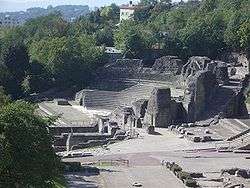Odeon of Lyon

The Odeon of Lyon is a small ancient Roman theatre near the summit of the Fourvière hill in Lyon, France. It forms a pair with the theatre, one of only two such pairs in Gaul (the other is in Vienne).
History
The ruins were still visible in the sixteenth century and was wrongly considered at the time as the amphitheater where the persecution in Lyon took place in 177. Sometimes regarded as a theater or auditorium by various authors (Claude Bellièvre, Gabriel Simeoni, Guillaume Paradin), the monument appeared in several texts and plans, and was eventually deemed as a cultural building.
The Odeon was built in the early to mid-second century. Archaeologists are reluctant on the date of its construction. The excavators date the building of the same period as the extension of the theater during the reign of Hadrian. It has a 73-meter diameter and a 3,000-seat capacity, which justifies its classification as Odeon, i.e. a covered building used for musical performances and reading public, less popular than the theater performances.
It was also used as meeting room for the notables of the city.
See also
| Wikimedia Commons has media related to Odeon of Lyon. |
Coordinates: 45°45′31″N 4°49′11″E / 45.75861°N 4.81972°E